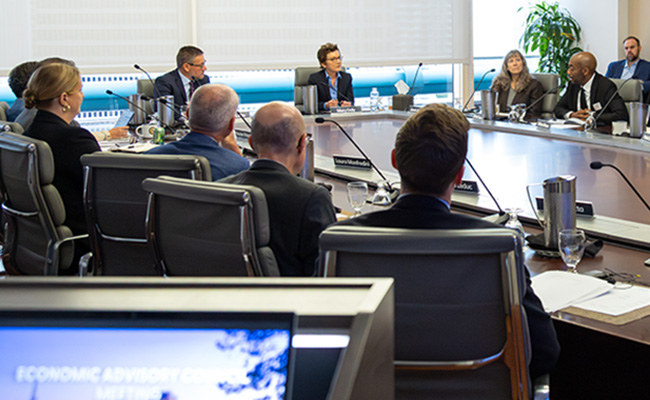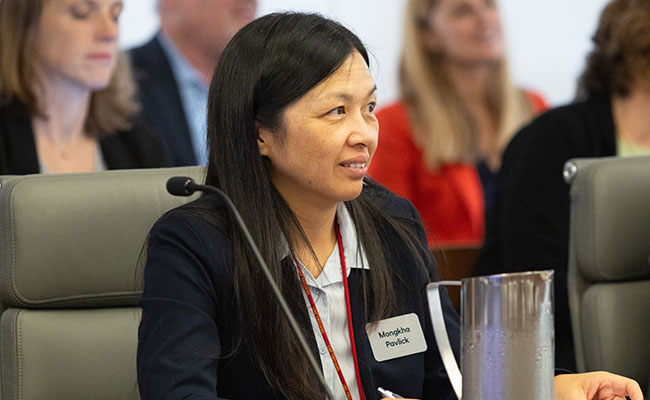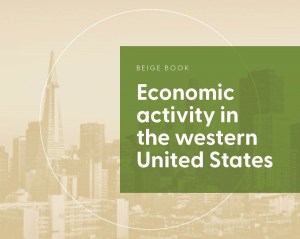The SF Fed maintains three advisory councils: the Economic Advisory Council, Community Advisory Council, and Community Depository Institutions Advisory Council. The members of these councils represent businesses, financial institutions, and community organizations across the Twelfth District. The councils regularly convene to discuss the District’s economy, bringing valuable perspectives from around the District to the SF Fed.
We have created Advisory Council Observations to share what we have learned. This series highlights key insights into Twelfth District economic conditions contributed by our councils in recent meetings.
Our advisory councils are a crucial source of on-the-ground insights about the Twelfth District’s economy, and each has a specific focus:
- The Economic Advisory Council (EAC) provides observations about the District’s economic, business, and labor conditions.
- The Community Advisory Council (CAC) serves as an important source of information on economic conditions in lower-income communities in the District.
- The Community Depository Institutions Advisory Council (CDIAC) shares information about banking conditions, the ability of community depository institutions to support local markets, and other issues of interest in the District.
President and CEO of the San Francisco Fed Mary C. Daly, other leaders from the Bank’s Executive Leadership Team and the Economic Research, Regional Engagement, and Banking Supervision groups attend twice-yearly council meetings and facilitate robust discussions. They ask council members to provide their assessments of the general health of the economy, while also surfacing specific short- and longer-term opportunities and concerns.
Here are some photos and key observations from the most recent meetings of the councils:
Economic Advisory Council

- Members of the Economic Advisory Council reported that economic activity slowed slightly in recent months. Elevated economic uncertainty strained business investment and hiring, but above-average liquidity allowed many businesses to proceed cautiously in the current environment.
- Council members generally reported stable to slightly higher costs and revenues across industries and geographies. Several Council members facing tariff-induced cost pressures preferred to keep their selling prices largely unchanged as they awaited further clarity on the ultimate scale and scope of trade policy adjustments, though some firms in retail trades and hospitality reported passing through higher import costs to their customers.
- Employment levels were down slightly as some employers left vacated positions unfilled. Labor costs were stable on balance as worker retention and labor availability were high, although it was still difficult to hire skilled trade and seasonal agriculture workers.
- Council members reported broad utilization of generative artificial intelligence (GenAI) tools to support back-end office operations and noted that they were already seeing notable productivity gains. Some expected employers across various industries to reduce their demand for labor going forward as a result of GenAI adoption.
Community Advisory Council

- Members of the Community Advisory Council reported that even as the inflation rate moderates, low- to moderate-income communities have continued to experience a widening gap, in nominal dollars, between their household income and costs of living.
- Council members discussed how shelter tops the list of widening affordability gaps in many Twelfth District communities. They discussed how all types of housing are increasingly more costly, alternative housing solutions have yet to have an impact, and contextual issues (immigration, availability and cost of materials, zoning, community resistance, and federal and state policy shifts) are negatively impacting efforts to increase affordable housing inventory.
- Conditions for small businesses and community-based organizations (CBOs) have become more challenging. Rapidly shifting labor and cost of goods sold conditions are spurring long-time small business owners to either sell or close at higher than typical rates. CBOs have faced analogous labor and goods issues while further struggling to absorb deep funding cuts. Many of them have already cut staff and are considering either merging or ceasing operations, while over this same time period demand for social services has substantially increased.
Community Depository Institutions Advisory Council

- Members of the Community Depository Institutions Advisory Council reported that many customers continue to prioritize convenience, expecting services to be offered via a mobile device. The gap between customers who demand high-tech solutions and those who do not is widening; accommodating both groups is difficult and requires simultaneous strategies. Community banks often rely on several third parties to meet customer needs.
- Council members discussed the increasing use of artificial intelligence (AI) across various banking functions, from credit assessment to back-office efficiency and customer-facing operations. AI is generally not being used to reduce headcount. Rather, it is enhancing employee efficiency, though training is needed to ensure maximum utilization.
- A couple of Council members were watching developments in the stablecoin space closely. They were interested in seeing what use cases develop and how bankers are monetizing those use cases.
- Fraud losses and prevention remain a significant issue. The prevalence and creativity of fraudulent account activity pose a barrier to expanding online account opening. Some bankers are exploring advanced detection mechanisms like biometric markers and AI overlay technology. Members also highlighted customer and employee education as an important area for improvement.
Advisory councils are a vital source of information for the SF Fed. They provide valuable insights into how businesses and households across the Twelfth District are navigating economic conditions on a daily basis. These insights help inform and support the SF Fed’s mission to advance the nation’s monetary, financial, and payment systems to build a stronger economy for all Americans.
The views expressed here do not necessarily reflect the views of the management of the Federal Reserve Bank of San Francisco or of the Board of Governors of the Federal Reserve System.



